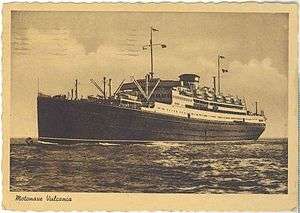MS Vulcania
 | |
| History | |
|---|---|
| Name: | MS Vulcania |
| Owner: | Cosulich Line[1] |
| Port of registry: |
|
| Route: | Trieste - Naples - New York City - Trieste |
| Builder: | Cantiere Navale Triestino, Monfalcone, Italy |
| Yard number: | 161[1] |
| Laid down: | 30 January 1926[1] |
| Launched: | 19 December 1926[1] |
| Completed: | 2 December 1928[1] |
| Fate: | Sank 1974 |
| General characteristics | |
| Type: | Ocean liner |
| Tonnage: | 23,970 GRT[1] |
| Length: | 181.58 m (595 ft 9 in)[1] |
| Beam: | 24.31 m (79 ft 9 in)[1] |
| Height: | 14.17 m (46 ft 6 in)[1] |
| Propulsion: | 25,000 HP diesel engine[1] |
| Speed: | 19 kn (35 km/h)[1] |
| Capacity: | 1760 passengers |
The MS Vulcania was an Italian ocean liner built by Cantiere Navale Triestino, Monfalcone, northern Italy in 1926 for the Italian company, Cosulich Line.
Characteristics
The second of three near-sister ships built for the Cosulich Line (the others were Saturnia and Urania), the Vulcania is considered one of the most successful passenger ships ever built. She was a 23,970 gross ton ship, with an overall length of 181.58 m and a beam of 24.31 m.[1] She had one funnel, two masts, twin screw and could reach a maximum speed of 19 knots. There was accommodation for 310 First, 460 Second, 310 intermediate and 700 3rd class passengers. In 1930 her accommodation was altered to 1st, 2nd, tourist and 3rd class, and in 1962 to 1st, tourist and 3rd class only. In 1930 she was fitted with new diesel engines which gave her a speed of 21 knots and was rebuilt to a tonnage of 24,469 tons. Although there had been various ships which offered private verandahs and promenades for the suites, both the Vulcania and the Saturnia were the first liners to offer a large number of cabins with private balconies. They were decorated in conservative classical style,[2] with works of art like Le Sirene, a 1934 woodden bas-relief by renowned artist Marcello Mascherini, displayed in the Tourist-class bar.[3]
History
Launched on 18 December 1926, she sailed from Trieste on her maiden voyage to Patras, Naples and New York City on 19 December of the same year. In September 1933 she transported the body of the Italian aviator Francesco de Pinedo to Italy from New York City after his death in a plane crash.[4] In December 1936 she commenced her last Trieste-New York voyage for Cosulich Line and in 1937 went to the newly formed Italia Line. In March 1937 she commenced running from Trieste to New York and in March 1940 commenced her last sailing Trieste - Naples - New York - Trieste. On April 26 she made a single voyage to South America from Trieste to Buenos Aires,[5] stopping in Naples, Genoa, Barcelona, Lisbon, Funchal, Bahia, Rio de Janeiro, Santos,[6] and was requisitioned by the Italian government in 1941 to carry troops to North Africa. In 1942-3 she was used on three special missions to repatriate women and children, Genoa - East Africa via South Africa.
In October 1943 she became a United States troopship and on 29 March 1946 was chartered to American Export Lines to run between New York - Naples - Alexandria. She commenced her last voyage on this service on 4 October 1946 after 6 round voyages and was returned to Italia Line on 15 November of that year. She then sailed New York - Naples - Genoa where she was reconditioned to carry 240-1st, 270-cabin and 860-tourist class passengers. In July 1947 she made a single voyage from Genoa to South America and then, on 4 September 1947, resumed the Genoa - Naples - New York service. On 21 September 1955 she commenced her last voyage on this run and on 28 October of the same year was transferred to run between Trieste, Venice, Patras, Naples, Palermo, Barcelona, Gibraltar, Lisbon, Halifax and New York. On 5 April 1965 she commenced her last voyage on this service and was sold to the Siosa Line who renamed her Caribia.[7]
She arrived at Barcelona on 18 September 1973 under tow to be scrapped and departed under tow for Kaohsiung for scrapping on 15 March of the following year, but sank before reaching the destination.[8]
Technology
The ship was powered by one of the largest two stroke diesel engines of its time. Its cylinders were of the double-acting type, in which combustion takes place both above and below the piston. This required the use of a crosshead.
References
- 1 2 3 4 5 6 7 8 9 10 11 12 Data from Industrial archaeology website
- ↑ HISTORY OF THE ITALIAN LINE and THE MS VULCANIA
- ↑ Le Sirene, Marcello Mascherini
- ↑ aeronautica.difesa.it Il portale dell'Aeronautica Militare: Francesco De Pinedo, il trasvolatore
- ↑ Marcello Mascherini's Works for Liners - Vulcania
- ↑ | Brazilian Museum of Immigration Passenger List
- ↑ http://www.naviearmatori.net/eng/foto-21875-4.html
- ↑ http://cruiselinehistory.com/history-of-the-italian-line-and-the-ms-vulcania
External links
- Photos of the ship
- Viaggio inaugurale della VULCANIA : film on YouTube archived by Archivio Storico Luce, originally published in Giornale Luce A0244 December 1928
- La grande motonave Vulcania: film on YouTube archived by Archivio Storico Luce, originally published in Giornale Luce B0813 on 8th January 1936